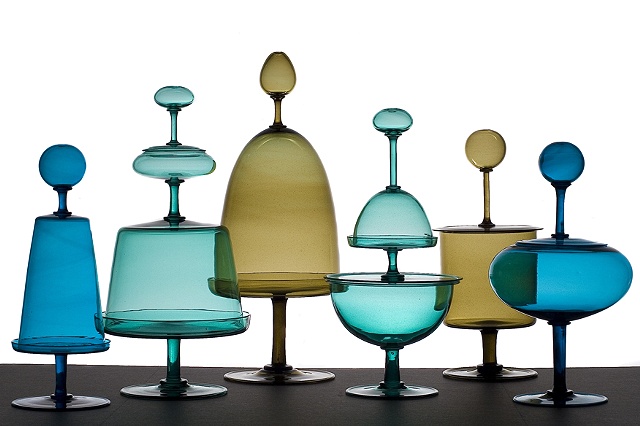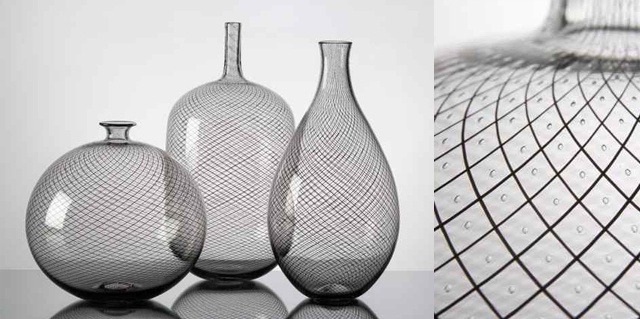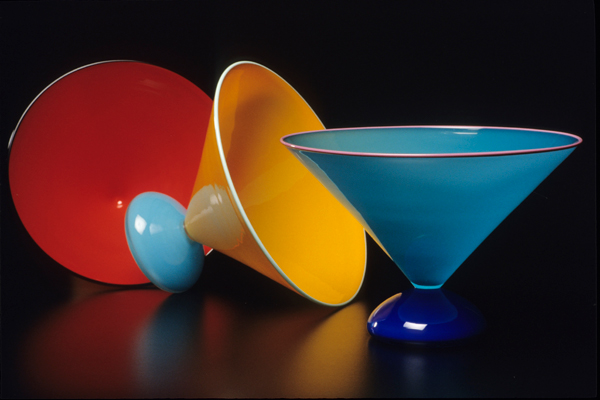Sam Stang, Greg Fidler, Michael Schunke, Katherine Grey, Boyd Seguki and Lisa Zerkowitz….If you are a fan of design – especially of contemporary art glass – you probably haven’t heard of these names. If these names are indeed foreign to you then I am sure you will be pleasantly surprised with the quality and originality of these contemporary American Glass Designers/Craftsmen. The Studio Glass Movement began in 1962 at the Toledo Musuem of Glass in Ohio. It was a workshop thrown together by Harvey Littleton and Dominic Labino that changed the face of glass production. As Americans have no true lineage in glass, we had to learn first through trial and error. Then we pushed forward by absorbing the techniques and approaches from other countries long-standing glass traditions, such as the Czech Republic, Italy, German, and England.
This set the tone for globalization in the Studio Glass Movement (a predominantly American movement) long before the world became flat again through the digital mediums. In contemporary glass design, we can still see the aftereffects of this journey towards material forefathers in the aesthetics and decorative techniques. The selection of work that I have chosen includes pieces influenced by Northern European Ceramics, and Italian Glass, both specifically from mid century designers.
The craftsmen influenced by ceramics are given the opportunity of translating the stunning work of Carl Harry Stahlhane, Stig Lindberg, and Meindert Zaalberg into glass and utilizing the inherent qualities of the material to find new shapes. The highest gloss possible in ceramics is easily surpassed by the natural finish of glass and bulbous forms are quickly created by the introduction of the craftsman’s breath in the vessel. The designers influenced by the Italian tradition find themselves in a wonderfully interesting dialogue between American and Italian Glass. The tradition that so heavily influenced the development of the Studio Glass Movement now finds itself surpassed by the creativity/ingenuity of the young american movement (within this context).
The Venetian Golden Age is generally considered to have occurred between 1930-1960 with a plethora of quality designers working on the island of Murano. Most importantly, the glass company Venini inviting designers from other backgrounds to work at the factory. Since the Venetian Golden Age, the level of creativity has slightly dwindled with the exception of a few individual maestros… Lino Tagliapietra, Livio Seguso, Davide Salvedore, ect. In the 1990s, Seattle passed Murano as the epicenter of glass design and sculpture. While some of the glass shown here is influenced by the Italian Glass tradition, it could actually be considered the most viable steward of that lineage.
Explore further
Two Tone Studio is the production studio of glass craftsmen Boyd Seguki and Lisa Zerkowitz. This husband and wife team blend contemporary design and everyday utility. Their series of cocktail-specific vessel sets are wonderful in their response to the each cocktail in terms of color, functionality, and traditional vessel shape. Two Tone Studio is located outside of Seattle and both Boyd and Liza graduated from the Rhode Island School of Design.
Ipso Facto Studio was founded by Greg Fidler and Brent Cole. The glass is currently produced by Greg at his studio in Bakersville, NC. The Form Studies are beautiful novellas of mid-century Swedish ceramic designs. They come in a variety of colors and each form is unique.
IBEX was founded by Sam Stang, David Levi, and Dimitri Michaelides in St. Louis and operated from 1985-1991. This powerhouse glass company produced designs that have been copied and distributed throughout the country.
You can find a selection of their designs at Vetri Gallery in Seattle.
After IBEX dissolved, Sam Stang began producing his own unique and production glass vessels. His work showcases a mastery of Venetian techniques applied to modernist forms. He now works out of Augusta, MO with his wife Kaeko Maehata.
Michael Schunke’s limited edition designs, marketed under Nine Irons Design, are shown throughout the country and produced in his West Grove, PA studio. He is one of the world’s preeminent goblet makers.
http://www.nineironstudios.com/
Katherine Grey is a contemporary glass artist who also produces some incredible functional designs that often fit neatly inside of each other. Katherine is the only craftsperson on the list that doesn’t run a production studio, but I love the work so much that it demanded to be included.






